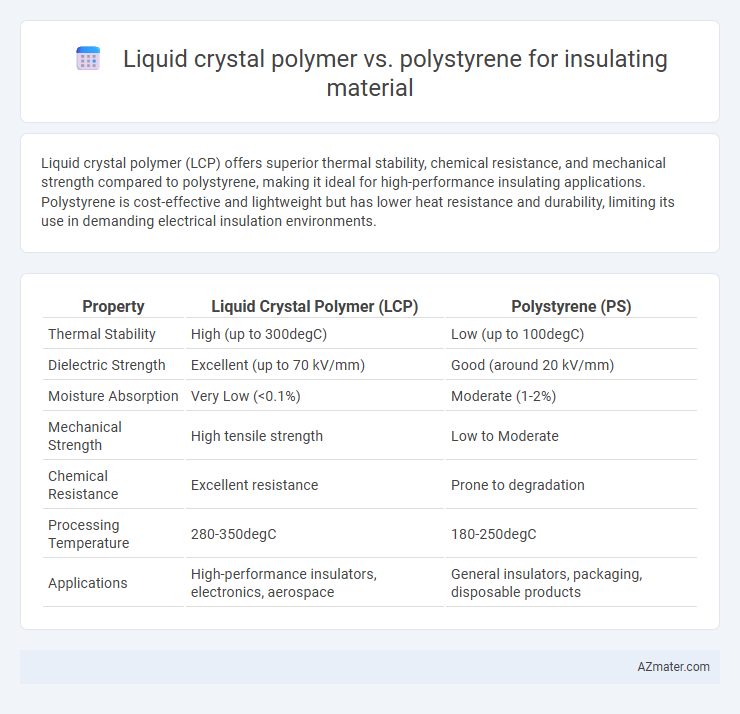Liquid crystal polymer (LCP) offers superior thermal stability, chemical resistance, and mechanical strength compared to polystyrene, making it ideal for high-performance insulating applications. Polystyrene is cost-effective and lightweight but has lower heat resistance and durability, limiting its use in demanding electrical insulation environments.
Table of Comparison
| Property | Liquid Crystal Polymer (LCP) | Polystyrene (PS) |
|---|---|---|
| Thermal Stability | High (up to 300degC) | Low (up to 100degC) |
| Dielectric Strength | Excellent (up to 70 kV/mm) | Good (around 20 kV/mm) |
| Moisture Absorption | Very Low (<0.1%) | Moderate (1-2%) |
| Mechanical Strength | High tensile strength | Low to Moderate |
| Chemical Resistance | Excellent resistance | Prone to degradation |
| Processing Temperature | 280-350degC | 180-250degC |
| Applications | High-performance insulators, electronics, aerospace | General insulators, packaging, disposable products |
Introduction to Liquid Crystal Polymer and Polystyrene
Liquid Crystal Polymer (LCP) is a high-performance thermoplastic known for its exceptional thermal stability, chemical resistance, and superior mechanical properties, making it ideal for advanced insulating applications. Polystyrene (PS), a widely used insulating material, offers good electrical insulation and is cost-effective but lacks the high-temperature performance and chemical resistance found in LCP. The unique molecular structure of LCP provides enhanced dimensional stability and low dielectric constant, whereas Polystyrene's amorphous structure allows ease of processing but with reduced thermal endurance.
Material Composition and Structure
Liquid crystal polymers (LCPs) consist of highly ordered aromatic polymer chains that exhibit both thermoplastic and liquid crystalline properties, resulting in exceptional thermal stability and mechanical strength. Polystyrene is a synthetic aromatic hydrocarbon polymer composed of repeating styrene monomers, featuring an amorphous and rigid structure with moderate thermal resistance. The molecular alignment in LCPs provides superior dielectric properties and higher dimensional stability compared to the random arrangement of polystyrene chains, which impacts its insulating performance and heat resistance.
Thermal Insulation Properties Comparison
Liquid crystal polymers (LCPs) exhibit superior thermal insulation properties compared to polystyrene due to their high thermal stability and low thermal conductivity, typically around 0.15 W/m*K for LCPs versus 0.033-0.04 W/m*K for polystyrene. LCPs can maintain structural integrity at temperatures exceeding 250degC, whereas polystyrene degrades rapidly above 100degC, limiting its thermal resistance in high-temperature applications. The crystalline molecular structure of LCPs provides enhanced thermal barrier performance, making them ideal for insulating applications requiring durability at elevated temperatures.
Mechanical Strength and Durability
Liquid crystal polymers (LCPs) exhibit superior mechanical strength and durability compared to polystyrene, making them ideal for high-performance insulating applications. LCPs possess high tensile strength and exceptional resistance to wear, heat, and chemical exposure, significantly outlasting polystyrene, which is prone to brittleness and lower impact resistance. The enhanced molecular alignment in LCPs provides consistent mechanical stability and long-term reliability under harsh operating conditions.
Electrical Insulation Capabilities
Liquid crystal polymer (LCP) exhibits superior electrical insulation properties compared to polystyrene due to its high dielectric strength and low dissipation factor, making it ideal for high-frequency and high-temperature applications. Polystyrene, while possessing decent electrical insulation capabilities, suffers from lower thermal stability and higher dielectric losses under stress, limiting its use in demanding electronic components. The inherent molecular orientation of LCP contributes to its dimensional stability and consistent dielectric behavior, outperforming polystyrene in advanced electrical insulation roles.
Chemical Resistance and Stability
Liquid crystal polymer (LCP) exhibits superior chemical resistance compared to polystyrene, effectively withstanding exposure to solvents, acids, and bases without degradation. The high thermal and dimensional stability of LCP enables consistent performance in harsh environments, surpassing the relatively lower stability and higher susceptibility to chemical attack found in polystyrene. These properties make LCP a preferred choice in applications demanding long-term insulation under aggressive chemical conditions.
Applications in Electrical and Electronic Industries
Liquid crystal polymers (LCPs) offer superior thermal stability, chemical resistance, and dimensional stability compared to polystyrene, making LCPs ideal for high-performance electrical connectors, flexible printed circuits, and microelectronic packaging. Polystyrene, while cost-effective and easy to mold, lacks the mechanical strength and thermal endurance needed for advanced electronic components subjected to high temperatures or harsh environments. LCPs facilitate miniaturization and high-frequency signal integrity in electrical applications, positioning them as premium insulating materials in cutting-edge electronic industries.
Environmental Impact and Sustainability
Liquid crystal polymers (LCPs) exhibit superior environmental sustainability compared to polystyrene due to their high thermal stability, recyclability, and longer lifecycle, reducing overall waste generation. Polystyrene, derived from petroleum and non-biodegradable, contributes significantly to environmental pollution and challenges in recycling infrastructure. The use of LCPs as insulating materials supports reduced carbon footprint efforts, making them a more eco-friendly choice in sustainable electronics and industrial applications.
Cost-Effectiveness and Market Availability
Liquid crystal polymer (LCP) offers superior thermal stability and mechanical strength compared to polystyrene, but its higher production costs result in less cost-effectiveness for large-scale insulation applications. Polystyrene is widely available and economically favored, providing acceptable insulation performance at a significantly lower price point, making it the predominant choice in mass-market insulation products. Market availability favors polystyrene due to its established supply chain and extensive use in construction and packaging industries, while LCP's niche status limits its accessibility and drives up procurement costs.
Summary: Choosing the Right Insulating Material
Liquid crystal polymers (LCP) offer superior thermal stability, chemical resistance, and mechanical strength compared to polystyrene, making them ideal for high-performance insulating applications. Polystyrene is cost-effective and provides good insulation properties for low-temperature and non-chemical environments but lacks durability under extreme conditions. Selecting between LCP and polystyrene hinges on the specific requirements for thermal endurance, mechanical robustness, and budget constraints in the insulation project.

Infographic: Liquid crystal polymer vs Polystyrene for Insulating material
 azmater.com
azmater.com